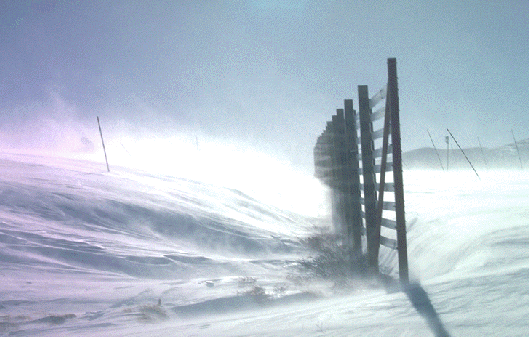 SNOW HYDROLOGY (GEOG 4321): BLOWING SNOW
SNOW HYDROLOGY (GEOG 4321): BLOWING SNOW  SNOW HYDROLOGY (GEOG 4321): BLOWING SNOW
SNOW HYDROLOGY (GEOG 4321): BLOWING SNOW

Snowfence and blowing snow,
Niwot Ridge, Colorado.
Nice overview by Don Cline, required for class .
Empirical observations
Type | Action | Height (cm) | Wind speed (m s-1) | Percent Load |
|---|---|---|---|---|
| creep | rolling | less than 1 | less than 5 | less than 10% |
| saltation | bouncing | 1-100 | 5-10 | about 80% |
| turbulent diffusion | suspension | more than 100 | more than 15 | less than 10% |
We have implemented a long-term snow fence experiment at the Niwot Ridge Long-Term Ecological Research (NWT) site in the Colorado Front Range of the Rocky Mountains in the USA to assess the effects of climate change on alpine ecology and biogeochemical cycles. The response of nitrogen (N) and carbon (C) dynamics in high-elevation mountains to changes in climate was investigated by manipulating the length and duration of snow cover with the 2.6x60\|m snowfence, providing a proxy for climate change. Results from the first year of operation in 1994 showed that the period of continuous snow cover was increased by 115 days relative to the control site and 90 days longer than at the snow fence site the year before construction (1993) [Brooks et al., 1995a]. We have implemented a long-term snow fence experiment at the Niwot Ridge Long-Term Ecological Research (NWT) site in the Colorado Front Range of the Rocky Mountains in the USA to assess the effects of climate change on alpine ecology and biogeochemical cycles. The response of nitrogen (N) and carbon (C) dynamics in high-elevation mountains to changes in climate was investigated by manipulating the length and duration of snow cover with the 2.6x60\|m snowfence, providing a proxy for climate change. Results from the first year of operation in 1994 showed that the period of continuous snow cover was increased by 115 days relative to the control site and 90 days longer than at the snow fence site the year before construction (1993) [Brooks et al., 1995a].
The deeper and earlier snowpack behind the fence insulated soils from winter air temperatures, resulting in a 9deC increase in annual minimum temperature at the soil surface and a 12deC increase at a depth of 15 cm. Warmer soils allowed microbial activity, measured as @co2@ flux, to continue through much of the winter. Carbon dioxide production under the deeper, earlier snowpack after construction of the snowfence was 55% greater than production before construction of the fence. The loss of @co2@ from snow-covered soils increased from about 20% of above-ground primary production before fence construction to 31% after fence construction, with shallow snow sites losing as little as 2% of above-ground primary production as @co2@. Surface litter decomposition studies were conducted to test if increased snow depth and duration behind the snowfence increased the rate of decomposition and N mineralization relative to controls. Initial results show that there was a significant increase in the litter mass loss under deep and early snow, with no significant change under medium and little snow conditions.
Snowpack duration and depth also appear to control soil N dynamics [Brooks et al., 1995b]. Under deeper, earlier accumulating snowpacks, N mineralization was generally higher (1712-1960\|@mgNm2@) and with smaller spatial variation (CV 4-26%) compared to shallow and later accumulating snowpacks (511-1440\|@mgNm2@, CV 42-83%). In contrast, the lowest nitrification rates were found under deep/early snowpacks (8-18% of mineralized N) compared to larger rates under shallow/late snowpacks (16-58% of mineralized N). These results are consistent with faster rates of decomposition under deeper/earlier snow producing more mobile N. Nitrogen and C dynamics in high-elevation mountain soils are very dynamic and appear to be sensitive to small changes in climate.
Microbial activity and other biological processes under snow may be as important to N and C cycling in high-elevation ecosystems as that occurring during the growing season [Brooks et al., 1996]. Small changes in climate that affect the timing, duration, and depth of snow cover may cause large changes in the N and C dynamics of alpine ecosystems. These biogeochemical changes in soil may in turn cause changes in plant community structure and composition. Further, N export in surface waters of high-elevation catchments is generally considered to be from the storage and release of @no3@ in seasonal snow [eg Williams and Melack, 1991]. These results suggest that microbial activity and N cycling under snow may control @no3@ export in these surface waters, and that small changes in climate may produce large changes in the chemical content of surface waters.
Readings for those interested (NOT REQUIRED!)
Department of Geography and
Institute of Arctic and Alpine Research
Comments and inquiries to: markw@snobear.colorado.edu
URL: http://snobear.colorado.edu/Markw/mark.html - Last modified Sunday, 22-Dec-96 15:19:19 MST
All contents copyright (C) 1995, INSTAAR and the University of Colorado
All rights reserved.